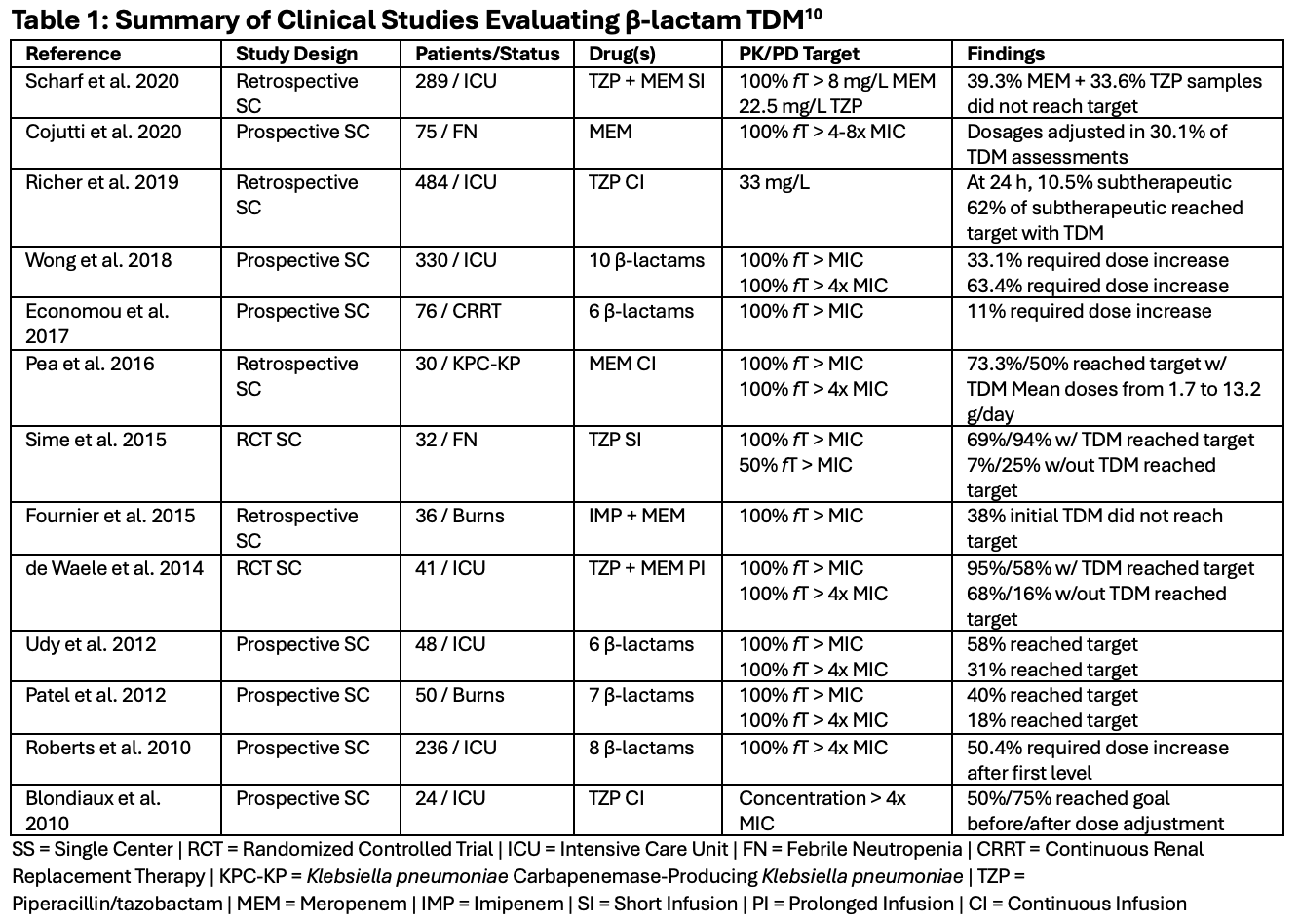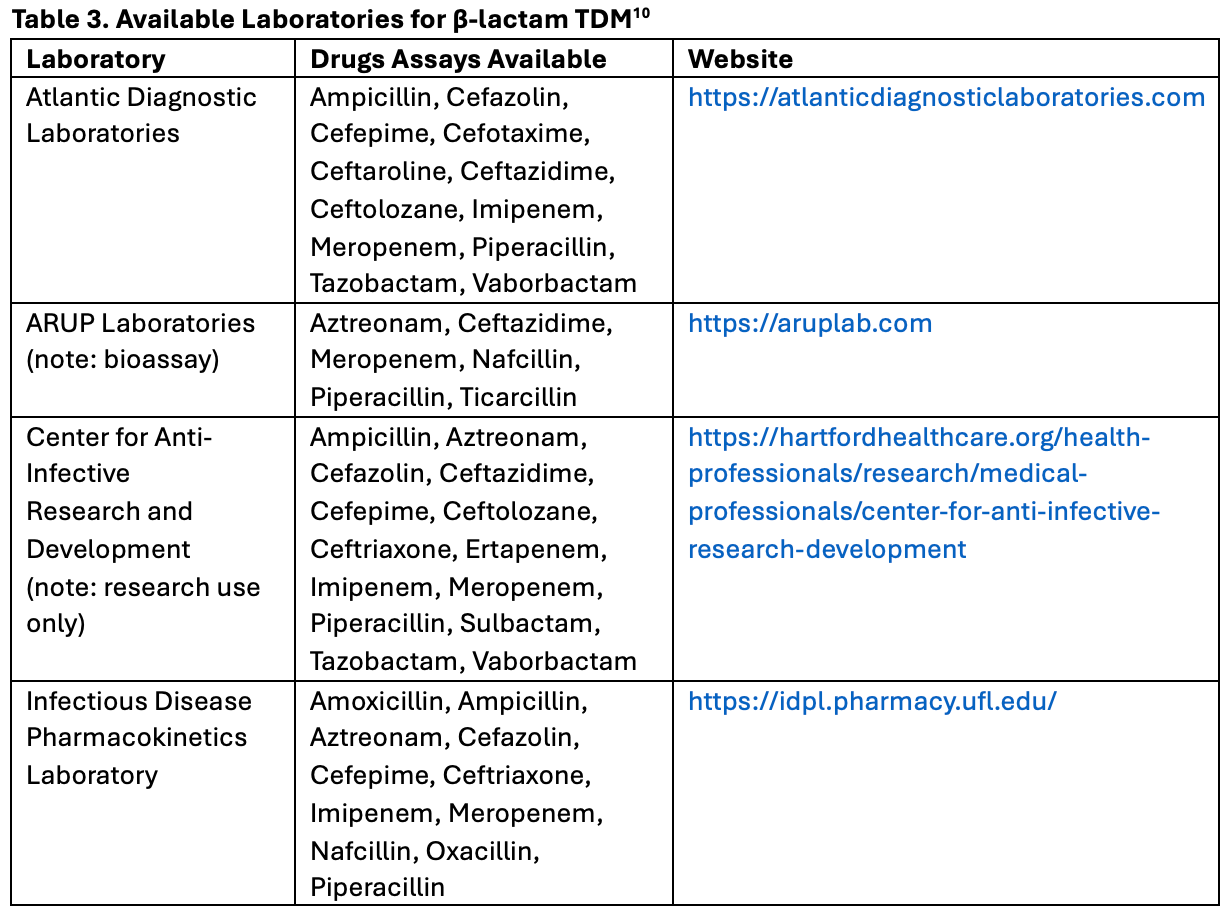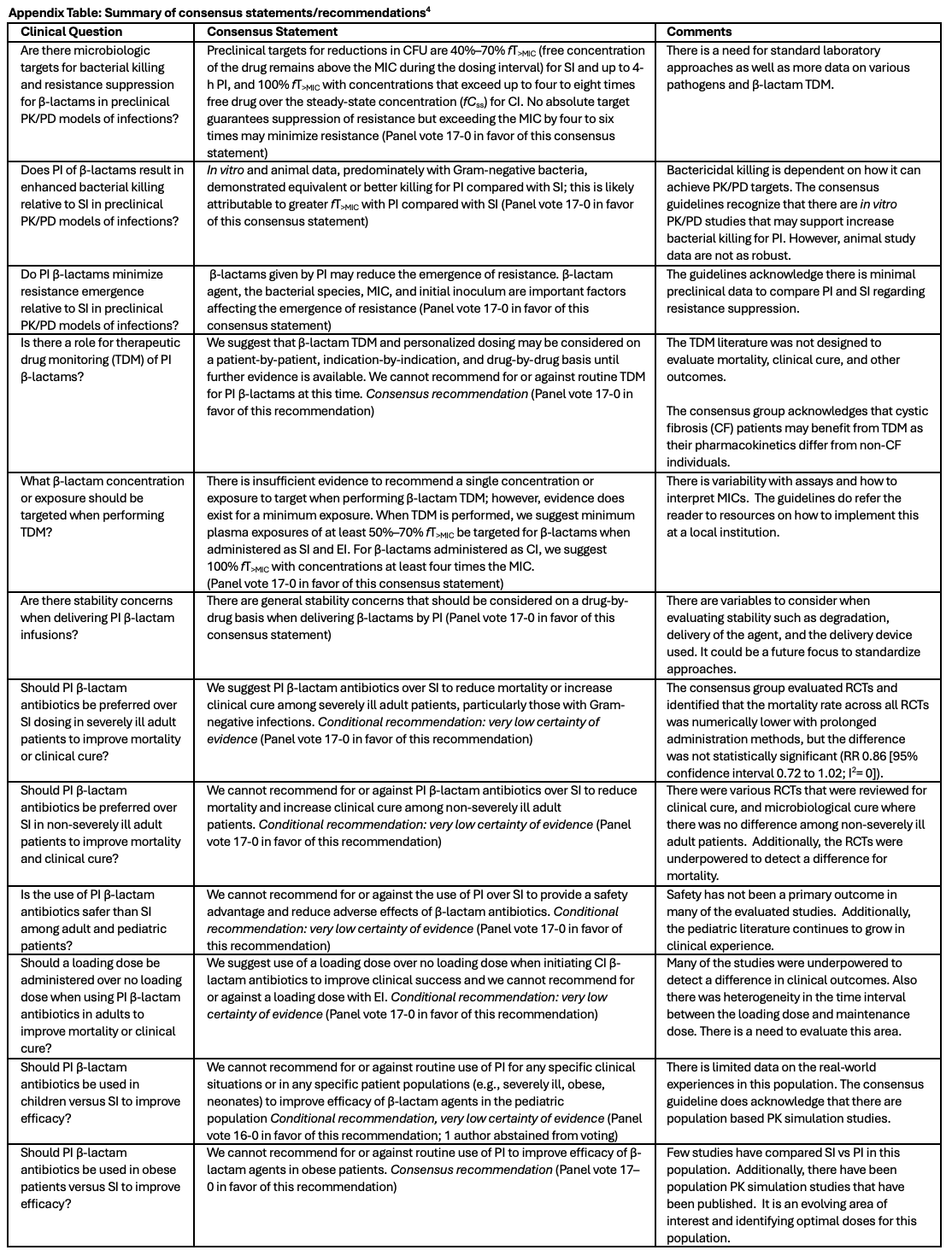Despite having been available for decades, intravenous (IV) β-lactam antibiotics remain first-line therapeutic options for severe infections and are generally considered to be the most effective class of antibiotics, assuming susceptibility has been demonstrated. At a concentration of 2 to 4 times the minimum inhibitory concentration (MIC), increased dosage, and therefore serum level, does not produce enhanced bactericidal activity.1 Results of in vitro studies, animal models, and both human exposure-response and clinical outcomes studies have consistently concluded that the time free drug concentration exceeds the MIC, as a function of the dosing interval (%fT > MIC), is the best pharmacodynamic (PD) correlate for efficacy.1,2 Despite these conclusions, the specific outcome measures on which they are based have varied, including log10 reductions in bacterial colony forming units (CFUs), clinical/microbiological efficacy, and/or mortality.3 Additional variability exists across the β-lactam class regarding the minimum %fT > MIC associated with 1 to 2 log10 reductions in bacterial CFUs – ≥50-60% for penicillin/monobactams, ≥50-70% for cephalosporins, and ≥40% for carbapenems.3,4
Although some studies have proposed alternative PD parameters for efficacy (e.g., area under the curve/MIC, trough/MIC), in these instances, nearly all included patients achieved 100% fT > MIC.3,4 As a result, outcomes bifurcated by %fT > MIC could not be assessed. No dose-fractionation studies are available in humans, though based on the totality of evidence, including dose-fractionation studies in animals, co-linearity amongst these PD targets is expected. For critically ill patients, a goal fT > MIC of 100% may be optimal, though the minimum thresholds outlined above remain reasonable targets, if 100% fT > MIC cannot be achieved.
Historically, IV β-lactam antibiotics have been administered using short infusion (SI) strategies – usually 30 to 60 minutes or less.5 However, with these SI dosing strategies, there may be instances where the serum concentration falls below the pathogen’s MIC (particularly for organisms with higher MICs, e.g., Pseudomonas aeruginosa), which can negatively impact bacterial killing, facilitate antibiotic resistance, and lead to poor patient-level outcomes. Furthermore, with continued, widespread use of this critical class of antibiotics, organism MICs have increased over time, as recently outlined by the CDC.6 Recognizing the ever-present threat of antimicrobial resistance, particularly in Gram-negative infections, 2 important strategies for optimizing the probability of PD target attainment exist for β-lactam antibiotics: prolonged/continuous infusions (PI/CI) and therapeutic drug monitoring (TDM).
From a pharmacokinetic (PK) perspective, the PI/CI approach maximizes time-dependent bactericidal activity, as it leads to sustained serum β-lactam concentrations above the MIC. The CI approach delivers the total daily β-lactam dose over 24 hours (e.g., cefepime 6g IV over 24 hours, piperacillin/tazobactam 18g IV over 24 hours, etc.), whereas the PI approach delivers the typical dose over 3 to 4 hours rather than 30 minutes (e.g., cefepime 2g IV Q8h over 3 hours, piperacillin/tazobactam 4.5g IV Q8h over 4 hours). Although PK/PD studies have clearly demonstrated improvements in %fT > MIC using PI/CI strategies, clinical outcomes studies have yielded mixed results.7
In 2021, a systematic review concluded that PI is safe, but the included data varied in populations studied, interventions employed, and outcomes.3 However, a subgroup analysis in critically ill patients demonstrated a benefit with PI for improved mortality, clinical cure, or both.3,4 Based on the included studies, patients experiencing critical illness and/or those with pulmonary infections are expected to benefit most from PI, though notably the effect size is more pronounced in non-randomized studies compared to randomized studies.3
In 2023, a double blind, randomized control trial (RCT) evaluated meropenem CI (3g IV over 24 hours) versus meropenem SI (1g IV Q8h over 30-60 minutes) in 31 intensive care units (ICUs) across Croatia, Italy, Kazakhstan, and Russia.5 This is the largest RCT evaluating PI/CI to date, with 607 patients enrolled. The primary outcomes of all-cause mortality and emergence of pan-drug resistant or extensively drug-resistant bacteria isolated at day 28 did not differ between SI and CI arms; however, it has been noted that this study may have been underpowered to detect a difference.7 Additionally, augmented renal clearance was not evaluated in this trial.5 Although a definitive conclusion on the benefits of PI/CI has yet to be reached, an international consensus guideline on the recommendations for PI of β-lactams was recently published and a summary of the recommendations can be found in the appendix.4
Although the data are generally supportive in recommending PI/CI infusion strategies for β-lactams over traditional SI strategies to improve the probability of PD target attainment, is PI/CI alone enough to ensure PD target attainment in critically ill patients with Gram-negative infections? The answer is a resounding no.
Compared to many drugs in which routine TDM is employed to avoid toxicity, β-lactams have a wide therapeutic index. However, the data informing dosing schema have largely been derived from healthy individuals and/or those who are not experiencing critical illness. As a result, contemporary dose adjustments are recommended based solely on end organ dysfunction—primarily renal insufficiency, which, at best, is difficult to accurately assess in patients with critical illness. While patients with sepsis may initially present with elevated biomarkers used to determine kidney function (e.g., serum creatinine, cystatin C, etc.), this is often a dynamic state, influenced by non-renal factors, that resolves quickly with appropriate supportive care. Early, appropriate dosing of β-lactam antibiotics in this setting is paramount.8
Additionally, critically ill patients with sepsis have many other factors that impact antimicrobial exposure. Changes in antimicrobial PK in response to sepsis/septic shock frequently include increases in volume of distribution due to capillary leak, higher unbound fraction of drug secondary to hypoalbuminemia or altered protein binding in the setting of acid-base disorders, decreased drug clearance due to end-organ dysfunction, and, perhaps most critically, a paradoxical increase in drug clearance due to augmented renal clearance (typically in younger patients and/or those with elevated body mass index).4,8,9 Furthermore, organ support modalities such as continuous renal replacement therapy (CRRT) and/or extra corporeal membrane oxygenation (ECMO) can cause substantial derangements in drug disposition.
Given the number of aforementioned factors which may cause significant aberrations in β-lactam exposure in the critically ill patient, it comes as no surprise that upwards of 60% of critically ill patients may not achieve optimal PD targets.10 Even more concerning is that many studies informing this estimate employed PI/CI β-lactam infusion strategies, though the data are largely non-randomized, with only 2 randomized controlled trials available to date. With β-lactam TDM and subsequent dose adjustments, however, critically ill patients are significantly more likely to achieve the desired PD target.11 Despite the reported improvement in probability of PD target attainment using a TDM-guided approach, a corresponding relationship with improved clinical outcomes has not been clearly established in individual studies. Reassuringly, however, a recent systematic review and meta-analysis concluded that β-lactam TDM was associated with improved clinical/microbiologic cure and decreased risk of treatment failure.11 No difference in mortality or length of stay was observed, though it’s likely many of the included studies were likely underpowered to detect such a difference.11 Given the frequent use of PI/CI strategies in TDM studies to date, it’s imperative to recognize that dose-optimization strategies alone are unlikely to achieve adequate PD targets in the majority of critically ill patients. Table 1 below summarizes clinical studies evaluating β-lactam TDM.10
Although no US-based guidelines exist regarding β-lactam TDM, French consensus guidelines are available.12 The French guidelines encompass not only TDM, but also many other strategies to optimize β-lactam PK/PD in critically ill patients, across their 21 best-practice recommendations. The recommendations related to β-lactam TDM are summarized as follows (optional recommendations – strong agreement for all:12
- R4.1 – Perform therapeutic drug monitoring in intensive care unit (ICU) patients with expected β-lactam PK variability and/or in patients with clinical signs potentially related to β-lactam toxicity.
- R4.2 – Perform β-lactam TDM in critical care patients undergoing renal replacement therapy.
- R4.3 – Perform β-lactam TDM by plasma trough concentration in case of intermittent administration and plasma steady state concentration in case of continuous administration.
- R4.4 – Perform β-lactam TDM 24 to 48 hours after the onset of treatment, after any change in dosage, and in the event of a significant change in the patient’s clinical condition.
- R4.5 – In case of central nervous system infection, perform β-lactam TDM, if possible, on blood and cerebrospinal fluid samples collected concomitantly.
- R4.6.1 – Perform β-lactam TDM according to a validated chromatographic method.
- R4.6.2 – β-lactam TDM results should be available to clinicians as soon as possible in order to have a real impact on ICU patient’s management.
- R4.7 – Consider as therapeutic targets the plasma concentrations presented in Table 2.
- R4.8.1 – In case of non-achievement of the target β-lactam plasma concentration, either:
- Increase the frequency of administration (i.e., further fractionate the dose) or switching to continuous administration, while maintaining the same daily dose
- Increase the unit dose administered discontinuously by 25 to 50% while maintaining the same frequency of administration
- R4.8.2 – In the case of persistence of below-target β-lactam plasma concentration despite one of the previous measures, switch to prolonged or continuous administration in combination with an increase of the β-lactam daily dose.
- R4.9.1 – In case of supra-therapeutic plasma β-lactam concentrations, either:
- Reduce the daily dose in the case of continuous administration
- Decrease the unit dose administered discontinuously by 25 to 50% while maintaining the same frequency of administration
- R4.9.2 – In case of extremely high concentration and/or signs of toxicity consistent with β-lactam overdose, stop administration and further resume the treatment after having checked the decrease in β-lactam concentration.
- R4.9.3 – Perform renal replacement therapy if acute renal failure is, at least partially, responsible for symptomatic β-lactam overdose.
Related to R4.6.1, when it comes to choosing a sampling methodology, 2 assays are generally available – bioassay or high-performance liquid chromatography (HPLC). HPLC is preferred to a bioassay approach because the bioassay may overestimate the true antibiotic concentration due to detection of active metabolites or presence of concomitant antibiotics with similar bioactivity.13 Most institutions will not have in-house access to β-lactam assays; however, several reference labs offer such services, as described in Table 3.10 While the turnaround time for results from these reference labs are relatively quick (typically several days), to be optimally useful, results would, ideally, be available in-house and reported in less than 24 hours, as recommended by the French guidelines.
Given the short half-lives of the β-lactams, TDM can be performed after 24 to 48 hours of treatment.10,12 Troughs are generally preferred in the setting of non-continuous administration, although 2-level sampling can be performed to allow for more precise pharmacokinetic calculations.10 Random steady state levels are used for continuous administration.
While β-lactams display linear PK, dose modification in response to TDM, like with all antibiotics, is often much more complex in critically ill patients. As with vancomycin, a Bayesian approach can be employed where the technology is readily available and a model exists; otherwise, traditional 2-level, first-order dose calculations can be performed.10 Absent either of the aforementioned approaches, either the empiric dose adjustments recommended by the French guidelines or a linear proportion can be used for patients receiving intermittent or continuous infusion β-lactams, assuming the same dosing interval is maintained (i.e., doubling the dose should approximately double the level). However, if a large change in level is necessary, adjusting from a 30-minute SI to a PI or CI (or vice versa) will result in a higher probability of target attainment, as the corresponding change in level will be greater than expected with a linear approach. If a PI or CI has already been employed and levels remain sub-therapeutic, increasing the total daily dose to achieve the desired PD targets in Table 2 is recommended.
About the Authors
Ethan A. Smith, PharmD, BCIDP, is an adult/transplant infectious diseases pharmacy specialist in the Department of Pharmaceutical Services at the UCLA Health Antimicrobial Stewardship Program at Ronald Reagan UCLA Medical Center in Los Angeles, California.
Ripal Jariwala, PharmD, BCIDP, AAHIVP, is an infectious diseases pharmacy specialist in the Department of Pharmaceutical Services at the UCSF Adult Antimicrobial Stewardship Program at UCSF Medical Center in San Francisco, California.
Based on the literature to date, it can be expected that many critically ill patients with sepsis will not achieve the desired β-lactam PD targets for optimal efficacy, especially those receiving CRRT and/or ECMO. The new international consensus guidelines on PI are a step in the right direction to translate data into practical recommendations the infectious diseases community can utilize, though there are remaining clinical conundrums in elucidating the ability of PI to achieve PD targets in all patients, especially those who are critically ill. More RCTs, such as the BLING III study, are anticipated and may offer additional insight into the potential benefits of PI.7
Hospitals should consider enhancing their electronic medical record to accommodate PI as an option for critically ill patients and/or those with Gram-negative infections, and notably, β-lactam TDM with corresponding dose adjustments will be instrumental in optimizing therapy, particularly in the face of increasing antimicrobial resistance. To truly optimize the utility of these assays, a fast turnaround time (e.g. within 24 hours) is essential. As data continue to develop in this arena, β-lactam TDM is likely to become more routine, as it has with drugs like vancomycin and the aminoglycosides.
References
Roberts JA, Paul SK, Akova M, et al. DALI: defining antibiotic levels in intensive care unit patients: are current β-lactam antibiotic doses sufficient for critically ill patients?. Clin Infect Dis. 2014;58(8):1072-1083.
Martinez MN, Papich MG, Drusano GL. Dosing regimen matters: the importance of early intervention and rapid attainment of the pharmacokinetic/pharmacodynamic target. Antimicrob Agents Chemother. 2012;56(6):2795–805.
Thabet P, Joshi A, MacDonald E, et al. Clinical and pharmacokinetic/dynamic outcomes of prolonged infusions of beta-lactam antimicrobials: an overview of systematic reviews. PLoS One. 2021;16(1):e0244966.
Hong L, Downes KJ, FakhriRavri A, et al.International consensus recommendations for the use of prolonged-infusion beta-lactam antibiotics.Endorsed by the American College of Clinical Pharmacy, British Society for Antimicrobial Chemotherapy, Cystic Fibrosis Foundation, European Society of Clinical Microbiology and Infectious Diseases, Infectious Diseases Society of America, Society of Critical Care Medicine, and Society of Infectious Diseases Pharmacists. Pharmacotherapy. 2023; 43:740-77.
Monti G, Bradic N, Marzaroli M, et al. Continuous vs Intermittent Meropenem Administration in Critically Ill Patients With Sepsis: The MERCY Randomized Clinical Trial. JAMA. 2023;330(2):141-151.
CDC. COVID-19: U.S. Impact on Antimicrobial Resistance, Special Report 2022. Atlanta, GA: U.S. Department of Health and Human Services, CDC; 2022. https://www.cdc.gov/drugresistance/covid19.html.Accessed 17 March 2024.
Shappell CN, Klompas M, and C Rhee. Do Prolonged Infusions of β-Lactam Antibiotics Improve Outcomes of Critically Ill Patients With Sepsis? JAMA. 2023;330(2):126-128.
Evans L, Rhodes A, Alhazzani W, et al. Surviving sepsis campaign: international guidelines for management of sepsis and septic shock 2021. Intensive Care Med. 2021;47(11):1181-1247.
Tamma PD, Aitken SL, Bonomo RA, et al. Infectious Diseases Society of America Antimicrobial-Resistant Treatment Guidance: Gram-Negative Bacterial Infections. Infectious Diseases Society of America 2023; Version 3.0. Available at https://www.idsociety.org/practice-guideline/amr-guidance/. Accessed 18 November 2023.
Fratoni AJ, et al. A guide to therapeutic drug monitoring of β-lactam antibiotics. Pharmacotherapy. 2021;41:220-33.
Mangalore RP et al. Beta-lactam antibiotic therapeutic drug monitoring in critically ill patients: a systematic review and meta-analysis. Clin Infect Dis. 2022;75(10):1848-60.
Guilhaumou R, et al. Optimization of the treatment with beta-lactam antibiotics in critically ill patients – guidelines from the French Society of Pharmacology and Therapeutics (Société Française de Pharmacologie et Thérapeutique—SFPT) and the French Society of Anaesthesia and Intensive Care Medicine (Société Française d’Anesthésie et Réanimation—SFAR). Critical Care. 2019;23(104):1-20.
Bastin MT. Therapeutic drug monitoring of beta-lactam antibiotics in critically ill patients with sepsis. University of Kentucky. 2021. DOI: 10.13023/etd.2021.075.











